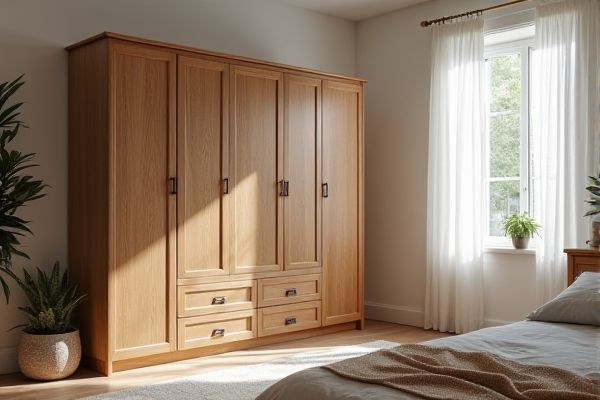
An armoire is typically a tall, freestanding cabinet with doors that conceal shelves and hanging space, often featuring intricate designs and used for storing clothes and linens. Your choice between an armoire and a wardrobe depends on your specific storage needs and room style; explore the article to discover which option suits you best.
Table of Comparison
| Feature | Armoire | Wardrobe |
|---|---|---|
| Definition | Freestanding cabinet with doors, often ornate | Large storage unit for clothes, usually simple design |
| Origin | French, traditional furniture | General term, modern and traditional use |
| Material | Solid wood, decorative finishes | Wood, metal, or composite materials |
| Size | Usually bulky, substantial presence | Varies; can be compact to large |
| Storage Features | Hanging space, shelves, drawers | Mostly hanging space, sometimes shelves |
| Style | Classic, antique, ornamental | Modern, minimalist, functional |
| Usage | Laundry, clothing, accessories | Primarily clothing storage |
| Mobility | Heavy, less portable | Varies; some lightweight models |
| Cost | Generally higher due to craftsmanship | Ranges from affordable to premium |
Introduction to Armoire and Wardrobe
An armoire is a tall, freestanding cabinet often featuring ornate designs, primarily used to store clothing and accessories. A wardrobe, more commonly found in bedrooms, serves as a larger storage unit with hanging space and shelves for clothes organization. Understanding the distinction between an armoire and a wardrobe helps you choose the best furniture for your storage needs and room aesthetics.
Defining Armoire: Features and Functions
An armoire is a tall, freestanding cabinet designed primarily for storing clothes, featuring doors that often conceal hanging space, shelves, and drawers within a compact structure. Its traditional design includes decorative elements such as ornate carvings and moldings, distinguishing it from a more utilitarian wardrobe. Understanding these features helps you choose the right storage solution based on your space and aesthetic preferences.
Understanding Wardrobe: Key Characteristics
A wardrobe is a tall, upright piece of furniture designed primarily for hanging clothes and storing folded garments in drawers or shelves. Typically constructed from wood or engineered materials, wardrobes often feature doors that can be hinged or sliding, providing easy access and saving space. Its functional design focuses on organization and efficient use of bedroom or dressing room space, distinguishing it from more ornamental furniture like armoires.
Historical Origins: Armoire vs Wardrobe
The armoire originated in 17th-century France as an ornate, freestanding storage piece designed to showcase craftsmanship and store valuables, often featuring elaborate carvings and curved lines. In contrast, the wardrobe emerged earlier in medieval Europe as a simpler, functional cabinet used for hanging clothes, typically characterized by straight lines and a boxy shape. Both pieces have evolved but maintain distinct historical roots reflecting their original purposes and cultural significance.
Design Differences: Structure and Style
Armoires typically feature a freestanding structure with ornate detailing, including carved wood and decorative moldings, reflecting classic or vintage styles. Wardrobes often present a more streamlined, built-in or modular design with clean lines and minimalist aesthetics, suited for modern interiors. Your choice between an armoire and a wardrobe should consider the desired blend of traditional craftsmanship versus contemporary practicality.
Storage Capacity and Versatility
Armoire offers greater storage capacity with multiple shelves, drawers, and hanging space designed for bulky items, making it ideal for maximizing room organization. Wardrobes typically provide more versatile modular compartments and adjustable rods, allowing you to customize the interior to fit different clothing types and accessories. Your choice depends on whether you need a spacious, all-in-one solution or a flexible storage unit adaptable to evolving wardrobe needs.
Material and Craftsmanship Comparison
Armoire furniture typically features solid wood construction such as oak, mahogany, or walnut, showcasing intricate hand-carved details that highlight exceptional craftsmanship and durability. Wardrobes often utilize a combination of engineered wood, plywood, or MDF with veneer finishes, offering a more affordable and lightweight option while sacrificing some robustness. Your choice between armoire and wardrobe should consider the quality of materials and artisanal techniques that impact longevity and aesthetic appeal.
Suitability for Different Spaces
Armoires are ideal for smaller or irregular spaces due to their compact, standalone design and often include drawers and shelves for versatile storage. Wardrobes, typically larger and built-in or freestanding, suit spacious bedrooms or walk-in closets by offering extensive hanging space and organization compartments. Choosing between an armoire and a wardrobe depends on room size, storage needs, and aesthetic preferences.
Price Range and Value Considerations
Armoires typically range from $800 to $3,000 depending on materials and craftsmanship, offering rich designs and solid wood construction that enhance long-term value. Wardrobes often cost between $200 and $1,500, providing affordable, modular storage solutions but may sacrifice durability and style. Choosing between an armoire and a wardrobe depends on balancing budget constraints with preferences for quality, aesthetics, and longevity.
Choosing Between Armoire and Wardrobe: Final Thoughts
Choosing between an armoire and wardrobe depends on your space, storage needs, and style preferences. Armoires often offer detailed craftsmanship and multi-functional storage with drawers and shelves, while wardrobes provide larger hanging space and customizable compartments for your clothing. Your decision should balance functionality with the aesthetic that best complements your bedroom decor.
 homyna.com
homyna.com